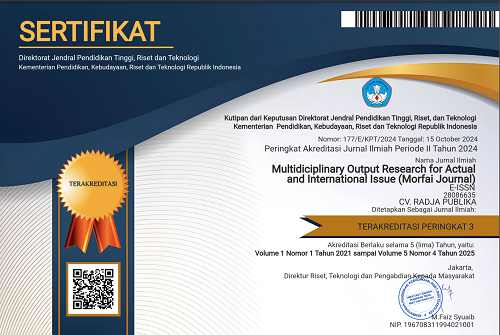THE EFFECTIVENESS OF USING THE DORATOON ANIMATION MAKER LEARNING MEDIA IN SEMANTIC COURSES IN INDONESIAN LANGUAGE AND LITERATURE EDUCATION STUDENTS FBS UNIMED
Main Article Content
Azhar Umar
Inayah Hanum
Trisnawati Hutagalung
This study discusses the effectiveness of learning Semantics courses using learning media based on Doratoon Animation Maker for students in the Indonesian Language and Literature Education Study Program. The purpose of this study was to see the effectiveness of Doratoon Animation Maker's teaching materials in the utilization of the learning process in Semantics courses. This population is all fourth semester students of the 2022/2023 academic year of the Indonesian Language and Literature Education Study Program. The sample of this research is the fourth semester students of regular class A in the 2022/2023 academic year of the Indonesian language and literature study program. The research instruments used were observation, questionnaires, and special tests. This research uses the Research and Development method. The results of this study, namely before using Doratoon Animation Maker learning media in Semantic learning get an average score of 67, 3 and after using Doratoon Animation Maker based learning media get an average of 85, 5.
Apriyanti, D., Syarif, H., & Ramadhan, S. (2021). Video feature making in esp-based public speaking class: A studentcentred learning in vocational higher education context. International Journal of Language Education, 5(1), 469–476. https://doi.org/10.26858/IJOLE.V5I1.15419
Chang, C. Y., & Hwang, G. J. (2019). Trends in digital game-based learning in the mobile era: A systematic review of journal publications from 2007 to 2016. International Journal of Mobile Learning and Organisation, 13(1), 68–90. https://doi.org/10.1504/IJMLO.2019.096468
Devina. (2022). Cross-linguistic influence of propositional and lexical semantics errors in Indonesian learner texts. Indonesian Journal of Applied Linguistics, 11(3), 527–538. https://doi.org/10.17509/ijal.v11i3.36618
Efendi, N. M. (2019). Revolusi Pembelajaran Berbasis Digital (Penggunaan Animasi Digital Pada Start Up Sebagai Metode Pembelajaran Siswa Belajar Aktif). Habitus: Jurnal Pendidikan, Sosiologi, & Antropologi, 2(2), 173. https://doi.org/10.20961/habitus.v2i2.28788
Faqih, M. (2021). Efektivitas Penggunaan Media Pembelajaran Mobile Learning Berbasis Android Dalam Pembelajaran Puisi. Konfiks Jurnal Bahasa Dan Sastra Indonesia, 7(2), 27–34. https://doi.org/10.26618/konfiks.v7i2.4556
Izzudin, A. M., & Suharmanto, A. (2013). Efektivitas Penggunaan Media Pembelajaran Video Interaktif Untuk Meningkatkan Hasil Belajar Praktik Service Engine Dan Komponen-Komponennya. Journal Unnes, 2(2), 1–8.
Kusmana, A. (2014). PENGEMBANGAN MODEL MATERI AJAR SEMANTIK: Penelitian dan Pengembangan Model Materi Ajar Semantik di Program Studi Bahasa, Sastra Indonesia, dan Daerah FKIP Universitas Jambi. Lentera Pendidikan : Jurnal Ilmu Tarbiyah Dan Keguruan, 17(1), 1–17. https://doi.org/10.24252/lp.2014v17n1a1
Mantasiah, R., Yusri, & Jufri. (2020). Semantic feature analysis model: Linguistics approach in foreign language learning material development. International Journal of Instruction, 13(1), 185–196. https://doi.org/10.29333/iji.2020.13112a
Muhibah, S. (2021). Model Video Pembelajaran Berbasis Animasi Sebagai Solusi. 8, 82–86.
Munawar, B., Farid Hasyim, A., & Ma’arif, M. (2020). Pengembangan Bahan Ajar Digital Berbantuan Aplikasi Animaker Pada PAUD Di Kabupaten Pandeglang. Jurnal Golden Age, 4(02), 310–320. https://doi.org/10.29408/jga.v4i02.2473
Nikmah, F. (2019). Analisis Makna Konotatif Dalam Dakwah Ustaz Hanan Attaki (Kajian Semantik). Jurnal Bahasa Lingua Scientia, 11(2), 219–236. https://doi.org/10.21274/ls.2019.11.2.219-236
Pradilasari, L., Gani, A., & Khaldun, I. (2019). Pengembangan Media Pembelajaran Berbasis Audio Visual pada Materi Koloid Untuk Meningkatkan Motivasi dan Hasil Belajar Siswa SMA. Jurnal Pendidikan Sains Indonesia, 7(1), 9–15. https://doi.org/10.24815/jpsi.v7i1.13293
Prastowo. (2014). panduan Umum Pengembangan Bahan Ajar. Diva Press.
Pujiastutik, H. (2017). Efektivitas Penggunaan Media Pembelajaran E- learning Berbasis Web pada Mata Kuliah Belajar Pembelajaran I Terhadap Hasil Belajar Mahasiswa. Jurnal Teladan, 4(1), 12. http://journal.unirow.ac.id/index.php/teladan/article/view/46
Ridha, M., Firman, F., & Desyandri, D. (2021). Efektifitas Penggunaan Media Video pada Pembelajaran Tematik Terpadu di Sekolah Dasar Saat Pandemi Covid-19. Jurnal Pendidikan Tambusai, 5(1), 154–162. https://jptam.org/index.php/jptam/article/view/925
Sugiyono. (2019). Metode Penelitian Kuantitatif, Kualitatif dan R&D. CV. Alfabeta.
Tambunan, S. S., Nahar, S., & Nasution, W. N. (2022). The Effect Of Free Drawing Ability And Emotional Intelligence On The Development Of Creativity For Children Aged 5-6 Years In Early Childhood Education Martabe Kasih , Silimabahal Village , Siborongborong District. Multidiciplinary Output Research For Actual and International Issue, 2(2), 451–456.
Zhou, Y., & Wei, M. (2018). Strategies in technology-enhanced language learning. Studies in Second Language Learning and Teaching, 8(2 Special Issue), 471–495. https://doi.org/10.14746/ssllt.2018.8.2.13
Azhar Umar , Universitas Negeri Medan, Medan
<strong>International Review of Practical Innovation, Technology And Green Energy (IRPITAGE)</strong> is a scientific journal that presents the results of scientific works sourced from Community Service in Indonesia. Contains All Forms of Novelty Innovations in both scientific science and technology, as well as issues of limited energy and the social environment in society.This journal is intended as a medium for scientific studies of research results from implementation to the community, thoughts and critical-analytic studies on various issues that can be utilized both nationally and internationally. The scientific article is in the form of a study of the implementation of Community Service that can be accounted for and disseminated nationally and internationally. IRPITAGE Journal from Radja Publika as part of the spirit of disseminating knowledge resulting from community service carried out by researchers in Indonesia. The IRPITAGE Journal from Radja Publika provides articles that can be downloaded for free. With a schedule of publications 3 (three) times a year.









